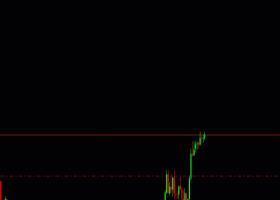Oil Correlation Tight For Now; Correlations Come/Go - Analysts
While risk appetite improved Tuesday, driven by a spike higher in oil prices, by tomorrow risk sentiment could sour on a turnabout lower in Chinese stocks and the next day could bring either new turmoil or euphoria, analysts said.
Market players have grown weary of what appears to be a close correlation between oil/Chinese stocks and the various asset classes, but at the same time acknowledged that the link may last a while longer.
"The curious point for the markets ... is why oil is driving everything else," said Marshall Gittler, head of investment research at FX Primus Europe.
"If it were because of oil's role as an indicator of economic activity, then collapsing oil prices would be a good barometer of a collapsing world economy and there'd be plenty of reason for stocks etc to fall in line with oil," he noted.
However, the correlation between oil and other other asset classes has risen to "unusually high levels," even as "the fundamental relationship between them is breaking down," Gittler said.
Oil prices have been on the decline not because of "a lack of demand but rather because of an increase in supply that's caused by technological change, which should be a good thing," he said.
Because of this, the oil-other asset class correlation "should be decreasing, not increasing," Gittler said.
The increased use of automatic trading may be another reason for the "higher correlation between oil and other asset classes" recently, he noted.
"It could be that computer-driven trading programs are picking up the fall in oil prices and trading automatically based on past relationships; Then other algorithmic trading programs pick up the pattern and trade on that in a self-reinforcing circle," Gittler explained.
Some analysts have said that what is also driving the oil-stocks correlation is the fear that the huge sovereign wealth funds of oil states are being pressured by low prices to sell assets to buttress the budgets of their parent countries.
Overall however, oil and other asset classes are likely to remain closely linked until there is "a visible improvement in the world economy that demonstrates the beneficial effects of lower oil prices," he said.
Stephen Jen, managing partner at SLJ Macro, noted that the correlation between the ISM manufacturing and non-manufacturing indexes has "declined sharply" since 2012, "from a historical range of 0.8-1.0 to around zero now."
"Since 2007, the US ISM-manufacturing has become highly positively correlated with commodity prices, somewhat contrary to popular presumptions," he said.
SLJ Macro maintained that "this may be due to the fact that the U.S. has actively participated in the building of production capacity in commodities in recent years."
So while theoretically, lower energy and commodity prices should act as a subsidy for the U.S. industrial sector, which was indeed the case up until 2007, as the U.S. became "a net producer, rather than a net consumer of commodities," world commodity price swings now drive ISM-manufacturing, Jen said
In this case, higher commodity prices equate to a stronger ISM manufacturing and vice versa.
In contrast, the ISM non-manufacturing sector is "driven by wealth, interest rates, purchasing power and less so by the global industrial sector," he said.
"Unless there is a sharp and substantial decline in wealth in the U.S., ISM non-manufacturing may remain relatively insensitive to the swings in ISM manufacturing," Jen said.
If non-manufacturing sector continues to outperform, "the Fed could remain under pressure to hike further as the unemployment rate falls toward 4.5% by this spring, with logical consequences for the dollar (up) equities (down) and other markets," he added.
Traders Tuesday were surprised to see U.S. equities rally in the face of a sharp 6.42% decline in Chinese stocks.
In prior sessions, a China stock tumble would have set a negative equity tone for other global stocks.
The relative calm may be partly because China's foreign exchange market has been stable in recent sessions.
Indeed, there was only modest weakness in the Chinese yuan Tuesday.
The dollar closed at 6.5826 versus the off-shore yuan, after trading in a range of CNY6.5788 to CNY6.5841.
The USDCNY high of CNY6.5962, posted Jan. 8, 2016, was the highest level seen since February 14, 2011 (CNY6.5980 high).
The 2011 peak was CNY6.6369, seen Jan 10. The PBOC intervened heavily Jan 12 to help narrow the spread between the on-shore and off-shore yuan.
The first week in January, the CNH-CNY spread widened to as much as 1,400 pips, as speculators entered into CNH shorts on expectations of a higher USDCNY.
This forced the PBOC to intervene, as one of the conditions of the yuan's entry into the IMF's SDR basket was to close the gap.
The CNH-CNY spread has narrowed substantially subsequently, with the spread nearly flat at one point in the wake of the intervention. The CNH-CNY spread at Tuesday's close was roughly 267 pips versus 300 pips at Monday's close.
"China has preferred to keep USDCNY fixings stable over the past two weeks, and we doubt this policy bias will change in the near term after China Vice President Li Yuanchao said that policymakers have no intentions to devalue the CNY," said strategists at Barclays.
"Nevertheless, we advise against complacency on USDCNY, given recent official signals for CNY NEER stability; we see USDCNY at 6.90 at end-2016," they said.
Analysts saw the Chinese yuan remaining stable at least until after the Lunar New Year holiday, which begins February 7, if not until the G-20 meeting of finance ministers and central bank governors taking place in Shanghai from Feb. 26-27.
Copyright © 2016 MNI
PS: Copy and Earn on Forex4you - https://www.share4you.com/en/?affid=0fd9105


